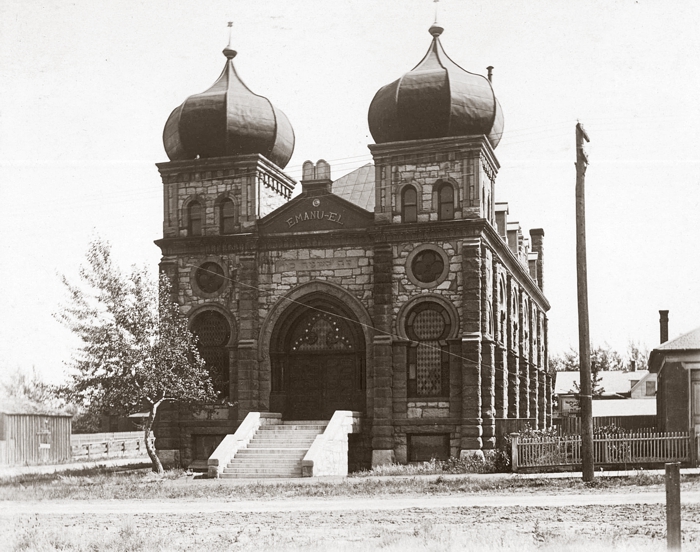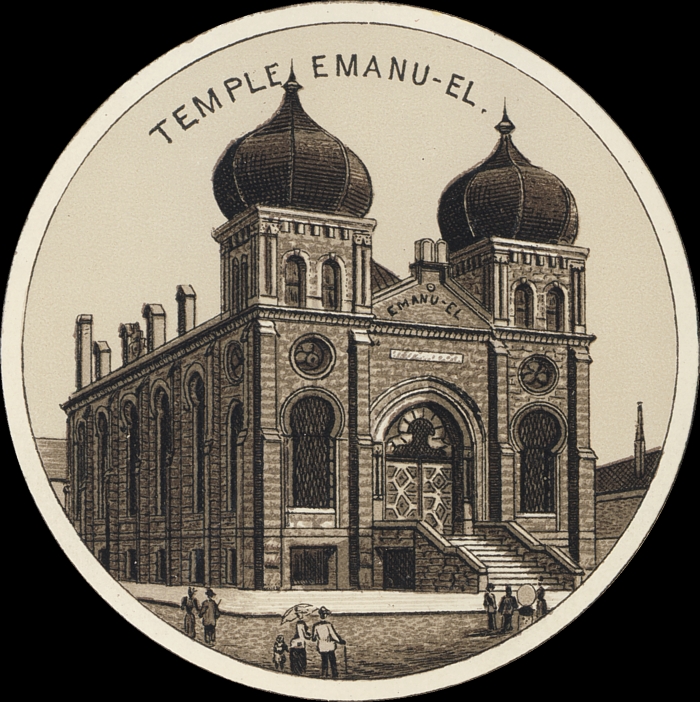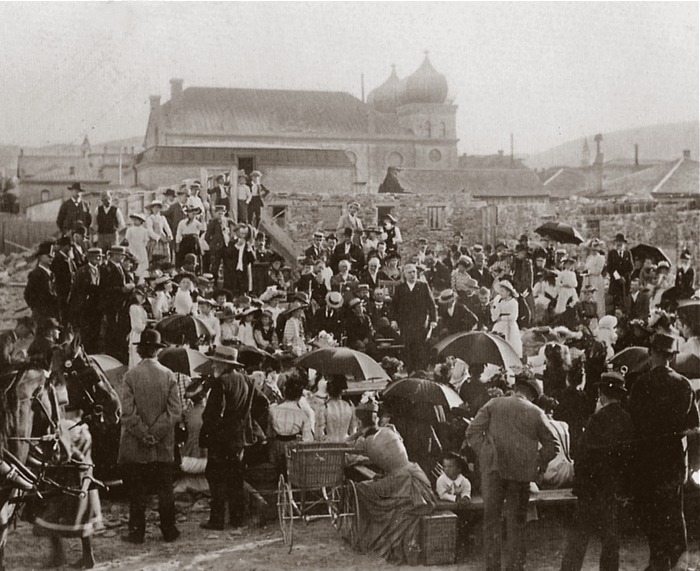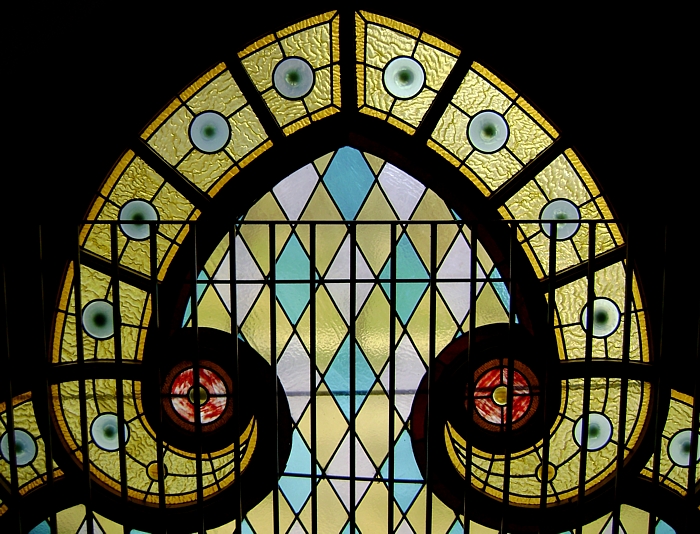|
To
Ornament the City
By Ellen Baumler
Published in Signature Montana, Summer 2008
Helena's
historic tree-lined North Ewing Street was once home to prominent
merchants, bankers, lawyers, and governors. The casual visitor,
however, would never guess that one of the most important
landmarks in the Northwest still graces the streetscape. Tucked
across a parking lot south of the historic First Presbyterian
Church, and east of the celebrated St. Helena Cathedral, is
another house of worship that once held a place of honor among
Helena's architectural and cultural landmarks. Today the Offices
of the Helena Diocese occupy the former Temple Emanu-El, the
first Jewish synagogue between St. Paul and Portland. The
building not only represents the crowning achievement of Helena's
once-vibrant Jewish community, it also is a stunning example
of preservation and adaptive reuse.
Montana's earliest Jewish pioneers came west from Prussia,
Bavaria, Austria, and Poland. Opportunity drew these immigrants
to the new mining settlements where business as well as religious
beliefs brought them together. In Helena, the United Hebrew
Benevolent Society, forerunner of the organized Temple congregation,
formed in 1866. Its members maintained Jewish holidays, assisted
the needy, and established the Home of Peace-Montana's oldest
active Jewish cemetery. By 1867, Jews owned seventeen of Helena's
twenty dry goods stores and Jewish merchants and service providers
had permanently settled with their families in the future
capital.
The Jewish community helped stabilize a fragile economy when
disastrous fires devastated the business district between
1869 and 1874. Jewish merchants and businessmen had ties to
a financial network that reached well beyond the Montana frontier,
allowing them the resources to rebuild, sometimes again and
again. Marcus Lissner, who ran Helena's acclaimed International
Hotel for example, lost his uninsured hostelry and rebuilt
it so many times during the 1860s and 1870s that it became
known as "the Phoenix."
At the end of the 1870s, twenty-percent of Helena's elite
Board of Trade was Jewish. The Masonic lodges embraced many
Jewish members, and citizens elected Jews to public office.
The Jewish community boasted lawyers, judges, bankers, merchants,
and service providers who owned some of Helena's most beautiful
homes. The prestigious Montana Club counted Jews among its
members.
The congregation, however, was without a rabbi and a place
of its own to worship. Merchant Herman Gans, while on a buying
trip to New York, persuaded Rabbi Samuel Schulmann to come
to Helena. Educated in Berlin, Rabbi Schulman brought with
him German Reform Judaism, which fit well with Helena's many
German Jews. Rabbi Schulman immediately took up the cause
to build a temple.
In October of 1890, the Helena community gathered as Governor
J.K. Toole laid the cornerstone. "Conscious of the sacred
duty which I have been invited to perform," said Governor
Toole, "…I now have the honor of laying the first
cornerstone of the first Jewish temple in the State of Montana."
With that, the governor struck the hollow granite block one
blow with a mallet as ceremony required. Herman Gans then
vigorously dealt the stone three more blows. Inscribed with
the date 5651 according to the Hebrew calendar, the granite
block still marks the building's northwest corner. Placed
inside were the names of congregation members and cards of
those present, coins, a quartz specimen, copies of the Helena
Independent and other items. Voices soared with the wind on
that October afternoon and the words carried through the neighborhood,
"Let pious hearts rejoice, to rear a sacred shrine…."
Architects Frederick Heinlein and Thomas F. Mathias, who were
not Jewish, learned how to design the synagogue from its members.
Keyhole windows borrowed from the Moorish style and Byzantine
rose windows combined with heavy stonework and Romanesque
style arches. Twin towers, originally capped with exotic black
star-spangled "onion" domes, made the temple a most
striking building. Stained glass of many colors softened the
rich interior of crimson, blue, and gold. The sanctuary rose
to a thirty-foot ceiling with a seating capacity of three
hundred. Seating could expand to five hundred with the addition
of removable galleries. All of Helena was proud of the temple,
which added considerably to the cosmopolitan aspirations of
the Queen City of the Rockies.
The congregation held an open house in April 1891. The magnificent
new temple, tastefully adorned with smilax and potted plants,
overflowed with curious visitors from all over the region.
Emotion overcame the little band who kept their faith alive
for more than twenty-four years. Herman Gans, the congregation
president, choked back tears as he explained, "…the
Jewish heart is ever loyal to the god of the fathers…no
matter how far removed from a religious center." It was
apparent to all how much this house of worship meant.
The following year, Rabbi Schulmann moved on and the congregation
was again adrift without a spiritual leader. Economic difficulties
and a lack of local job opportunities as the second generation
of these pioneers came of age severely diminished the congregation.
By the 1930s, the small remnant group could not maintain the
synagogue. Their leader, Norman Winestine, sadly arranged
for the sale of the organ and pews to the Seventh Day Adventists.
The State of Montana acquired the temple for a token price
of one dollar and a promise to use the building for a "good
and social purpose."
The state readied the former temple for its new function as
offices for Social and Rehabilitation Services, dividing the
sanctuary into two stories and removing all religious symbolism.
Sandblasting of the Hebrew inscription, "Gate to the
Eternal," above the entry and removal of the star-studded,
painted domes visually divested Helena of a significant part
of its cultural heritage. The copper was likely reused to
re-clad the State Capitol's dome at about the same time. The
keyhole windows, some of colored stained glass, and the Hebrew
year on the cornerstone, however, remained undisturbed [Remodeling
began in late 1935, but a permit was not issued for the work
until January of 1936. - KB].
That the state would so carefully remodel the temple during
the depressed 1930s is a marvel. The unknown architect who
added the second story in such a way that it hardly disturbed
the multi-storied windows deserves much credit for his sensitivity.
At a time when preservation and adaptive reuse were hardly
in an architect's vocabulary, the work done to convert the
temple is a masterpiece of care and consideration and one
of the first preservation efforts in the West.
After decades of office use, the temple stood vacant from
1976 to 1980, serving as off-site storage for the Montana
Historical Society. Norman Winestine feared its demolition.
He was discouraged and disappointed when the state put it
up for sale. But when the Catholic Diocese of Helena purchased
the former temple for $83,000, the state more than recouped
its small investment and everyone came out ahead. Since 1981,
the beloved Temple Emanu-El has been well cared for and maintained
as offices of the diocese and the building has come full circle.
Distinguished with listing in the National Register of Historic
Places in 2000, the former Temple Emnu-El continues to reflect
the intent of its congregation. When Herman Gans accepted
the keys to the building at its dedication in 1891, he explained
to the crowd that the temple was to be an honor to Helena's
Jewish pioneers and an ornament to the city they loved. Through
careful stewardship, the legacy endures.
|








